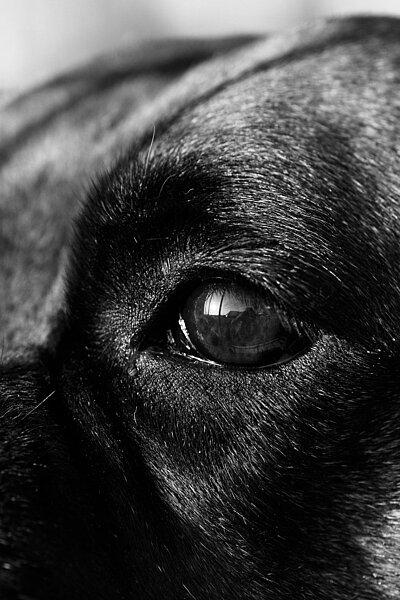Eye diseases

Dogs can suffer from various eye diseases that can affect their vision and well-being. Some of these are congenital, others are caused by age, injury or infection. In this article you will learn more about the symptoms, causes and treatments of common eye diseases in dogs.
Cataracts
A cataract is a clouding of the lens that prevents light from reaching the retina. This causes the dog's vision to deteriorate. Cataracts can be congenital or develop over the course of a dog's life, for example due to diabetes or ageing.
Symptoms
- Blue-white discoloration of the lens
- Difficulties with orientation
- Behavioral changes due to decreasing vision
Treatment
Cataracts cannot be treated with medication. The only way to improve vision is surgery to replace the cloudy lens with an artificial lens. However, this is not always possible or appropriate, depending on the condition of the dog and the retina.
Glaucoma
Glaucoma is an increase in intraocular pressure that damages the optic nerve and can lead to blindness. Glaucoma can be caused by impaired drainage of the aqueous humor in the eye or by a tumor or inflammation.
Symptoms
- Reddened eyes
- Dilated pupil
- Sensitivity to light
- Pain in the eye
- Enlarged eyeball
Treatment
Glaucoma must be treated quickly to prevent permanent damage to the optic nerve. Treatment consists of medication to lower the intraocular pressure or an operation to improve aqueous humor drainage or remove the tumor.
Conjunctivitis (inflammation of the conjunctiva)
Conjunctivitis is an irritation or infection of the conjunctiva covering the eye. It can be triggered by draughts, foreign bodies, allergies or bacteria. Conjunctivitis is usually harmless, but unpleasant for the dog.
Symptoms
- Severe blinking or squinting of the eye
- Heavy lacrimation or purulent discharge
- Red eyes
- Itching
- Nictitating membrane prolapse (the third eyelid is visible)
Treatment
Depending on the cause, conjunctivitis is treated with eye drops or ointments that have an anti-inflammatory, antibacterial or anti-allergic effect. Sometimes systemic medication such as antibiotics is also necessary.
Other eye diseases in dogs
In addition to those mentioned, there are other eye diseases in dogs that occur less frequently or are less well known. These include, for example
- Progressive retinal atrophy: a hereditary degeneration of the retina that leads to progressive blindness.
- Uveitis: An inflammation of the inner eye that can have various causes and is often accompanied by pain and redness.
- Eye tumors: Benign or malignant growths in the eye or eyelids that can impair vision or bleed.
- Entropion: An inward misalignment of the eyelid that causes the eyelashes to rub against the cornea.
- Ectropion: A misalignment of the eyelid towards the outside, which leads to the cornea drying out.
How do I recognize an eye disease in my dog?
If you notice one or more of the following signs in your dog, you should take him to the vet to rule out or treat an eye disease:
- Change in eye color or shape
- Change in pupil size or reaction
- Change in vision or orientation
- Change in the appearance or amount of eye discharge
- Change in the dog's behavior or mood
How can I promote my dog's eye health?
There are some simple steps you can take to promote your dog's eye health, such as
- Checking your dog's eyes regularly for abnormalities and gently cleaning them with a damp cloth when necessary.
- Keeping the hair around your dog's eyes short to avoid irritation.
- Protect your dog from draughts, dust, smoke or sharp objects that could irritate his eyes.
- Have your dog wormed and vaccinated regularly to prevent infections.
- Feed your dog a balanced diet and give him plenty of water to improve his general health.
The authors assume that a veterinarian should be consulted if an animal is ill and that medication should only be taken after consultation with a doctor or pharmacist. Only an individual examination can lead to a diagnosis and treatment decision.
We help you find the nearest vet → This way